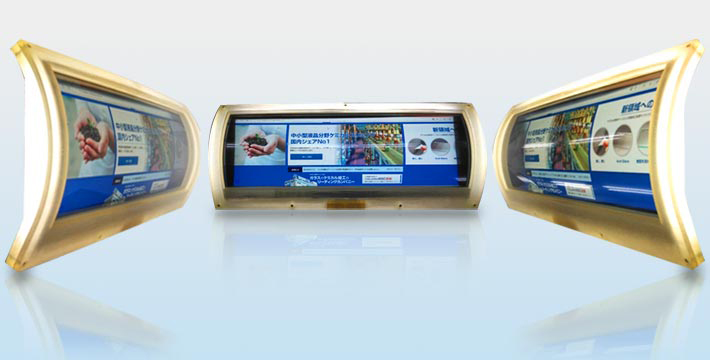Ultra-thin slimming of glass substrates to a measurement of 100μm or thinner

(Ultra-Thin Glass Processed to a Thickness of 0.05mmt)
LCD substrates and cover glass for mobile devices such as smartphones and tablets, as well as curved displays for televisions and vehicles, are demanding the ultra-thin glass slimming process technology more than ever.
To respond to the needs for ultra-thin glass thinner than the conventional ones, NSC has established its original technology of single substrate chemical etching process.
Features
Ultra-thin glass, with a minimum bending radius of 5mm
Combination with ion exchange glass strengthening gives the ultra-thin glass high flexibility which allows the glass sheets to be folded to the minimum bending radius of 5mm.
NSC has been inventing bendable glass panels with this processing technology.

Lighting confirmation of curved LCD prototype panel
Ultra-thin processing to LCD panel; thickness 1.00mmt becomes 0.15mmt.
Radius of curvature R100mm.
Maintains viewing angle characteristics of IPS liquid crystal even in curved state.
Available Sizes
NSC’s ultra-thin chemical etching process can uniformly process large-sized glass substrates measuring up to 1,500 mm × 1,850 mm (G6). Glass substrates are laid flat during the process, so as to prevent warping of the substrate. The thinnest measurement ultra-thin slimming process can reach is 30μmt. Because this process does not need carriers for conveyance, no jig marks will leave on the substrates.
| Target glass thickness [μm] | Processable maximum size [μm] | Single sheet | Mounted substrate |
|---|---|---|---|
| 30 | 200×200mm | ◯ | – |
| 50 | 400×500mm | ◯ | – |
| 100 | 1500×1850mm | ◯ | ◯ |
Processable substrate size differs according to the target thickness. The above graph is presented as one of the examples. For details in other conditions, please contact us.
Strength
Since chemical etching does not produce any minute flaws (micro-cracks), the strength of the glass surface is about 2 times greater than that possible with mechanical grinding.
| Type | Process | Thickness [μm] | Radius of curvature [mm] | ||||||
|---|---|---|---|---|---|---|---|---|---|
| 44 | 33 | 26 | 24 | 16 | 10 | 5 | |||
| Glass | Ultra-thin +Ion exchange glass strengthening | 50 | ○ | ○ | ○ | ○ | ○ | ○ | ○ |
| Glass | Ultra-thin | 50 | ○ | ○ | ○ | ○ | ○ | × | – |
| LCD panel | Ultra-thin | 50 / 50 | ○ | ○ | ○ | ○ | × | – | – |
○: No damage , ×: Damaged
Thickness
At NSC, slimming a glass workpiece to a thickness measurement of 0.25mmt or thinner is defined as “ultra-thin slimming.” Up to now NSC is capable of ultra-thin slimming to a thickness measurement of 30μmt.
Thickness accuracy within a substrate
|
Single sheet |
→0.05mmtUltra-thin slimming process to a thickness measurement of 0.05mmt |
|
Mounted substrate |
→0.10mmtUltra-thin slimming process to a thickness measurement of 0.10mmt |
Uses and Applications
Specific Examples
- Curved displays
- Flexible displays
- Organic EL lighting
- Glass films
- High-strength thin glass
